
The Hispanic population spans Europe and the Americas, as well as multiple socioeconomic classes in various countries.
Not unlike the rest of the world, the Hispanic population across the globe is in the midst of an ongoing overfat pandemic. A 2017 study estimated that up to 76 percent of individuals worldwide may be overfat,1 although a recent study argued that this figure may be underestimated.2
Overfat is defined as excess body fat, particularly abdominal visceral fat, that impairs health. This condition encompasses those who are overweight and obese, and can also occur in 20-40 percent of normal weight people depending on ethnicity.
Overfat promotes chronic inflammation and insulin-resistance, increasing disease risk and leading to chronic illness. These cardiovascular and metabolic (cardiometabolic) conditions may initially be associated with abnormal cholesterol and triglycerides, blood-sugar irregularities and rising blood pressure that can lead to heart disease, stroke, diabetes, hypertension, cancer, Alzheimer’s, and other chronic diseases. Rates of these preventable conditions have also grown with the overfat pandemic.1
Those who are overfat also have increased risk for infectious diseases due to immune impairment, as a recent study described in relation to COVID-19.3 In addition, overfat is associated with physical impairments including injuries and pain.
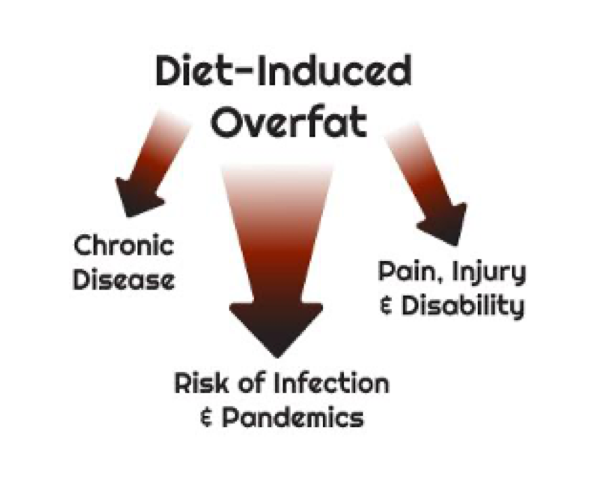 This article estimates the overfat Hispanic population for most of the Americas and Spain, and includes a separate analysis for Brazil.
This article estimates the overfat Hispanic population for most of the Americas and Spain, and includes a separate analysis for Brazil.
Global vs. Hispanic Populations
The Hispanic population is particularly interesting due to its heterogeneity, spanning Europe and the Americas, as well as multiple socioeconomic classes in countries in various stages of development. All of this contributes to rates of overfat in different ways.
Two important factors in public health and healthcare have caused the overfat pandemic to go overlooked and under-addressed, not only in Latin American populations but in Hispanics and other ethnicities worldwide. Firstly, the continued use of body mass index (BMI) as a proxy of health makes it difficult to discern overfat and related cardiometabolic illness. Secondly, studies show that the prevalence of metabolic disease at the same BMI is much higher for Hispanics and other ethnicities than for Whites.4 In short, reported rates of overweight and obesity underestimate the prevalence of overfat.
Developed countries have a proportionally larger share of overfat people, with rates in the 20 most developed countries ranging from more than 60 percent to over 90 percent overfat.5 In the case of the United States, over 90 percent of adults and about 70 percent of children were overfat, with another study showing only 12 percent of Americans were metabolically healthy.6 However, developing countries have now replaced infectious disease and starvation as their No. 1 health problem with overfat. For example, 80 percent of adults in India were shown to have excess body fat.7
Latin America Overfat Analysis
The present analysis estimates the overfat pandemic in Hispanic populations, including South America, Mexico, Spain, and other countries, using data from the the Institute for Health Metrics and Evaluation (IHME).8 We include Argentina, Chile, Uruguay, Antigua and Barbuda, Barbados, Belize, Cuba, Dominica, Dominican Republic, Grenada, Guyana, Haiti, Jamaica, Saint Lucia, Suriname, Trinidad and Tobago, Bolivia, Ecuador, Peru, Colombia, Costa Rica, El Salvador, Guatemala, Honduras, Mexico, Nicaragua, Panama, Venezuela, Paraguay and Spain. Brazil is also highlighted.
Our analysis of Latin American adults (age 20+) shows that about 74 percent of men and 76 percent of women are overfat. This reflects the recent dramatic increase in overfat prevalence in the Spanish-speaking world, and is further detailed below. Like other populations, this rapid rise appears primarily due to the increased globalization and easy access to highly processed and inexpensive high-carbohydrate “junk” foods — especially refined carbohydrates and sugar.9,10
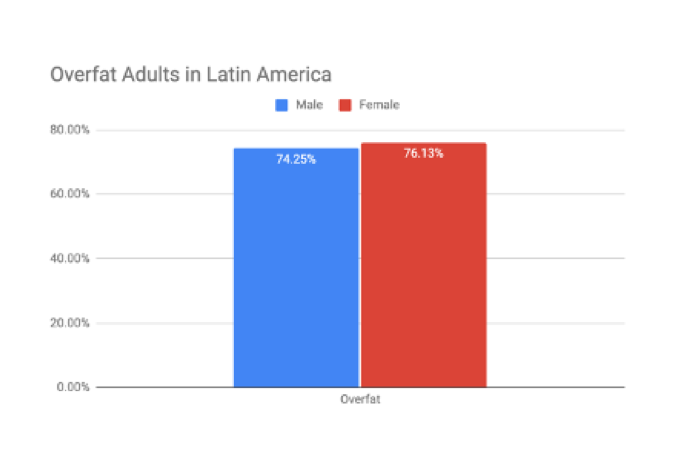 While overall rates of overfat in Latin America are lower than in the previously mentioned U.S. paper, it is worth noting that Latin America has a wide spectrum of countries in different stages of development, with lesser-developed countries typically having a lower overfat population, but a higher burden of underweight and malnutrition, which has previously been associated with the term “underfat.”1
While overall rates of overfat in Latin America are lower than in the previously mentioned U.S. paper, it is worth noting that Latin America has a wide spectrum of countries in different stages of development, with lesser-developed countries typically having a lower overfat population, but a higher burden of underweight and malnutrition, which has previously been associated with the term “underfat.”1
We also analyzed Mexico, Brazil and Spain separately to illustrate the progression of overfat prevalence.
The analysis demonstrates that higher-income Latin American countries follow a similar trend to the U.S. We estimated that in 1980, the prevalence of overfat in Mexico was 68 percent for men and 72 percent for women, whereas by 2015 it reached 79 percent in men and 81 percent in women. In 1980, Brazil had a prevalence of 58 percent for men and 62 percent for women, which reached 73 percent for men and 75 percent for women by 2015.
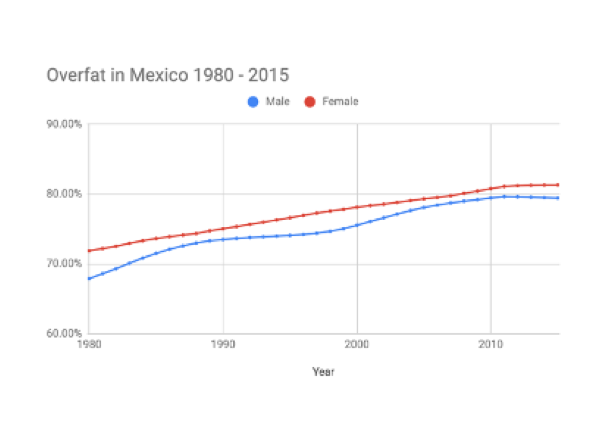
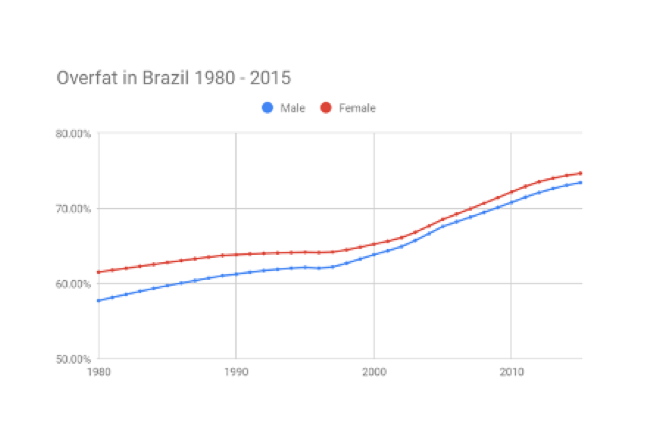
Spain has seen its overfat trend rise as well, but it appears to have decreased slightly in the last decade. For the current study, the Spanish population was considered to be White for the purposes of estimating overfat levels, as the Hispanic population studied in Gujiral et. al. (with greater prevalence of metabolic disease) was composed primarily of Mexicans and South Americans whose greater prevalence is likely due to a combination of economic, cultural, and geographic factors specific to the Americas, as well as Native American genetic ancestry that is absent from the Spanish population.
A study by De Bont J (2020) found that between 2006 and 2016, prevalence of overweight/obesity decreased from 41 to 40 percent in boys and from 40 to 38 percent among girls.11 This tracks similarly to our overfat calculations from the adult IHME data, which shows that between 2000 and 2016 overfat decreased from 75 to 72 percent in men and from 63 to 60 percent in women. If this decreasing trend is maintained, Spain may be the first country globally to recently show a diminished overfat population.
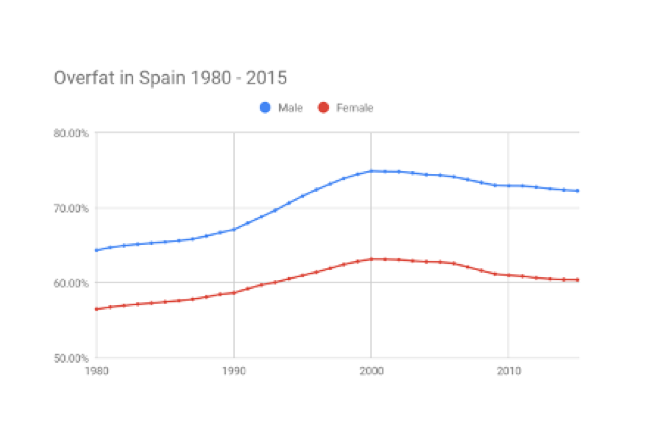
The seriousness of the overfat pandemic in the Hispanic population illustrates the emergence of an extreme phenomenon in which excess body fat and the consequent chronic diseases, higher infection rates and physical disabilities, creates a negative burden on the healthcare systems of each nation, society at large, and the quality of life of individuals.
This has become the new normal worldwide due to refined food and the reduction in physical activity following the Western standard set by the United States.
References
- Maffetone, P. B., Rivera-Dominguez, I., & Laursen, P. B. Overfat and Underfat: New Terms and Definitions Long Overdue. Front pub health. 2017;4:279. doi: 10.3389/fpubh.2016.00279.
- Maffetone, P. B., & Laursen, P. B. Revisiting the Global Overfat Pandemic. Frontiers in public health. 2020;8,51. doi: 10.3389/fpubh.2020.00051.
- Maffetone, Philip B, and Paul B Laursen. “The Perfect Storm: Coronavirus (Covid-19) Pandemic Meets Overfat Pandemic.” Front pub health. 2020;8(2):135. doi: 10.3389/fpubh.2020.00135.
- Gujral UP, Vittinghoff E, Mongraw-Chaffin M, Vaidya D, Kandula NR, Allison M, et al. . Cardiometabolic abnormalities among normal-weight persons from five racial/ethnic groups in the United States: a cross-sectional analysis of two cohort studies. Ann Intern Med. 2017;166:628–36. doi: 10.7326/M16-1895
- Maffetone, P. B., Rivera-Dominguez, I., & Laursen, P. B. Overfat Adults and Children in Developed Countries: The Public Health Importance of Identifying Excess Body Fat. Front pub health 2017;5:190. doi: 10.3389/fpubh.2017.00190.
- Araújo J, Cai J, Stevens J. Prevalence of Optimal Metabolic Health in American Adults: National Health and Nutrition Examination Survey 2009–2016. Met Syn Rel Dis, 2018; doi: 10.1089/met.2018.0105.
- Maffetone, P. & Khopkar, M. The overfat pandemic in India. 2018.
- Institute for Health Metrics and Evaluation (IHME). Epi Visualization. Seattle, WA: IHME, U Wash. 2016. Available from http://vizhub.healthdata.org/epi/. (Accessed [Oct 12, 2020])
- Popkin BM. The nutrition transition and obesity in the developing world. J Nutr. 2001;131:871S–873S.
- Uauy R, Albala C, Kain J. Obesity trends in Latin America: transiting from under- to overweight. J Nutr. 2001 Mar;131(3):893S-899S. doi: 10.1093/jn/131.3.893S. PMID: 11238781.
- de Bont J, Díaz Y, Casas M, García-Gil M, Vrijheid M, Duarte-Salles T. Time Trends and Sociodemographic Factors Associated With Overweight and Obesity in Children and Adolescents in Spain. JAMA Netw Open. 2020;3(3):e201171. doi:10.1001/jamanetworkopen.2020.1171.








